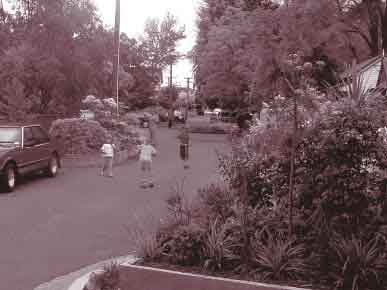| Our Environment: Issue 26 Autumn 2001 |
 A quiet revolution is occurring in our city streets. They are being redesigned as
“Living Streets” with people and communities, not just cars, in mind.
A quiet revolution is occurring in our city streets. They are being redesigned as
“Living Streets” with people and communities, not just cars, in mind.
The concept is based on the idea that residents, businesses, pedestrians, cyclists and other users should have, at the very least, equality with cars. Streets are being constructed for walking, jogging, watching, talking, scooting and many other past- times.
A new booklet produced by the City Council says that a Living Street encourages better driving behaviour and discourages heavy trucks and throughtraffic on most local roads. “Any street, apart from a motorway or expressway which has a pure transit function, can become a Living Street,” it says.
The City Council’s City Streets unit is proposing that the following roads be developed as Living Streets as part of the first phase of implementing this concept: Papanui East Cluster, Harvey Terrace, Main Road (Redcliffs), a cluster of streets in Charleston, Mathers Road, Aynsley Terrace, Saltaire Street, Geraldine Street, Creyke Road and Papanui Road.
These streets will be included in a showpiece portfolio that will show how the concept is applied to street renewal developments. Funding for all but two of the specified projects has been included in the 2001/2002 Annual Plan.
Community street
This type of street is mainly residential, with traffic calming measures such as speed humps. It provides easy and safe access for all ages and abilities, interconnected walkways, convenient areas for cars and other vehicles, and places for recreation and other activities. (For example Bangor Street in the Avon Loop and Roundtree Street and Hanrahan Street in Upper Riccarton.)
Walkable street
This has mixed residential and commercial use eg shops, schools, dentists and doctors rooms, offices and cafes, among or alongside homes of various styles. A walkable street is often slightly wider than a community street but still offers places for leisure walking for all abilities and some recreation spaces. (For example Barnes Road in Redwood and Leslie Street in Upper Riccarton.)
Small public areas
These provide pleasant recreational space in mainly commercial areas. Often situated next to a busy street, the small urban space helps merge the business environment with the community and sometimes hosts retail displays or small events eg corner of Victoria and Salisbury Streets. Comfortable seating, lighting and clear visibility are features of this style of Living Street.
Mixed use street or boulevard
This street is often predominantly commercial and incorporates more of a designed and constructed environment eg New Regent Street, Cashel Mall and Worcester Boulevard.
Quiet street
This refers to mainly residential streets that have been “calmed” to allow both residents and cars equal use eg Ely Street in the inner city, and Lavandula and and Witbrock Crescents in Burnside. Restraints such as speed humps, platforms, carriageway offsets, raised intersections, narrowed carriageways and kerb extensions help create a livable environment.
In addition the Living Street concept can be extended along street boundaries. Taking in footpaths, unfenced frontages, berms, kerbs and channels, landscaping, street trees and lighting, these streets invite interaction with adjacent buildings, gardens and parks eg Washington Reserve, Catherine Street Woolston, and Fitzgerald Avenue Bridge area.
The Living Street strategy says the redesigned streets contribute to our quality of life through:
Lucas Sikiotis, Support Manager in City Streets, says the City Council is committed to creating more Living Streets throughout the city and intends to do so by phasing in a programme over five years. “By changing our traffic and transport priorities we can enjoy a better balance between pedestrians, cyclists, public transport, taxis, service vehicles and private cars.”
Jennie Hamilton
| Our Environment Index |